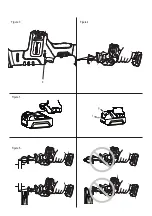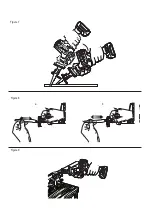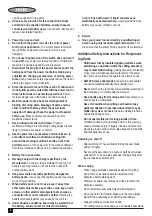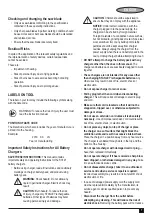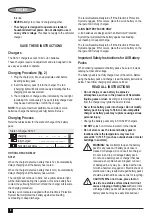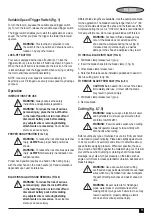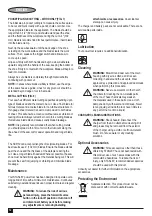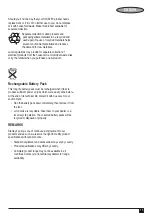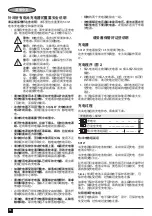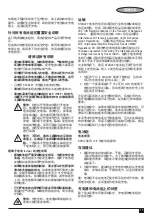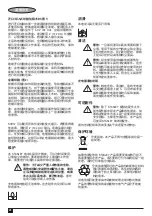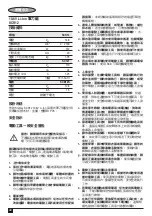
12
ENGISH
POCKET/PLUNGE CUTTING – WOOD ONLY (FIG. 7)
The initial step in pocket cutting is to measure the surface area
to be cut and mark clearly with a pencil, chalk or scriber. Use
the appropriate blade for the application. The blade should be
longer than 3-1/2" (89 mm) and should extend past the shoe
and the thickness of the workpiece during the cut. A 4" (102
mm) blade is recommended for best performance. Insert blade
into the blade clamp.
Next, tip the saw backward until the back edge of the shoe
is resting on the work surface and the blade clears the work
surface. Then, squeeze the trigger switch and allow saw to
come up to speed.
Grip saw firmly with both hands and begin a slow, deliberate
upward swing with the handle of the saw, keeping the bottom of
the shoe firmly in contact with the workpiece. Blade will begin to
feed into material.
Always be sure blade is completely through material before
continuing with pocket cut.
NOTE: In areas where blade visibility is limited, use the edge
of the saw shoe as a guide. Lines for any given cut should be
extended beyond edge of cut to be made.
METAL CUTTING (FIG. 9)
Your saw has different metal cutting capacities depending upon
type of blade used and the metal to be cut. Use a finer blade for
ferrous metals and a coarse blade for non-ferrous materials. In
thin gauge sheet metals it is best to clamp wood to both sides
of sheet. This will ensure a clean cut without excess vibration or
tearing of metal. Always remember not to force cutting blade as
this reduces blade life and causes costly blade breakage.
NOTE: It is generally recommended that when cutting metals
you should spread a thin film of oil or other lubricant along the
line ahead of the saw cut for easier operation and longer blade
life.
The SCR12 can accept all lengths of reciprocating blades. For
best results use 4" (102 mm) blades. Ensure the blade extends
past the shoe and the thickness of the workpiece during the
cut. Use a longer blade if needed. Whenever possible, the saw
shoe must be held firmly against the material being cut. This will
prevent the saw from jumping or vibrating and minimize blade
breakage.
Maintenance
Your
STANLEY
power tool has been designed to operate over a
long period of time with a minimum of maintenance. Continuous
satisfactory operation depends upon proper tool care and regular
cleaning.
WARNING: To reduce the risk of serious
personal injury, place the forward/reverse
button in the lock-off position or turn tool off
and disconnect battery pack before making
any adjustments or removing/installing
attachments or accessories. An accidental
start-up can cause injury.
The charger and battery pack are not serviceable. There are no
serviceable parts inside.
Lubrication
Your power tool requires no additional lubrication.
Cleaning
WARNING: Blow dirt and dust out of the main
housing with dry air as often as dirt is seen
collecting in and around the air vents. Wear
approved eye protection and approved dust mask
when performing this procedure.
WARNING: Never use solvents or other harsh
chemicals for cleaning the non-metallic parts
of the tool. These chemicals may weaken
the materials used in these parts. Use a cloth
dampened only with water and mild soap. Never
let any liquid get inside the tool; never immerse
any part of the tool into a liquid.
CHARGER CLEANING INSTRUCTIONS
WARNING: Shock hazard. Disconnect the
charger from the AC outlet before cleaning. Dirt
and grease may be removed from the exterior
of the charger using a cloth or soft non-metallic
brush. Do not use water or any cleaning
solutions.
Optional Accessories
WARNING: Since accessories, other than those
offered by
STANLEY
, have not been tested with
this product, use of such accessories with this
tool could be hazardous. To reduce the risk of
injury, only
STANLEY
, recommended accessories
should be used with this product.
Consult your dealer for further information on the appropriate
accessories.
Protecting the Environment
Separate collection. This product must not be
disposed of with normal household waste.



